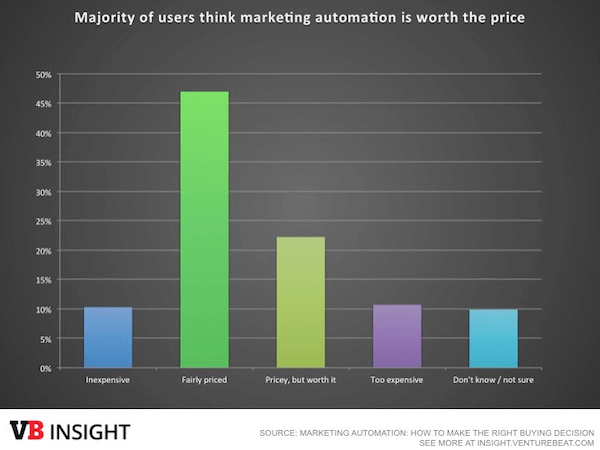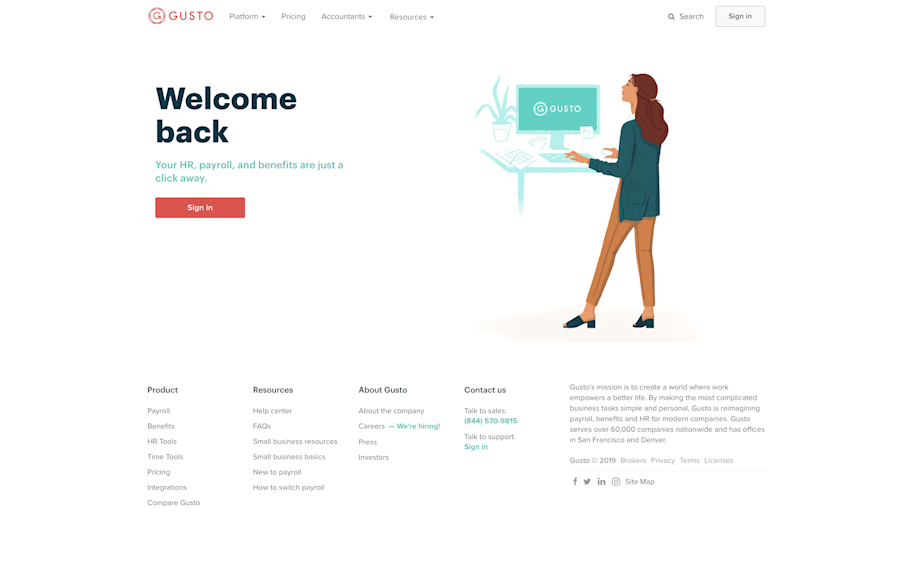Lead generation is a time-consuming, but essential, part of keeping any business competitive and thriving. The good news? Switching to automated lead generation can save time, increase productivity, and get you higher-quality leads, all of which contribute to greater revenue growth!
In 2024, 64% of marketers now use AI and automation software to generate more leads, with the majority testifying to the ROI it delivers.
But, even with great software at your fingertips, there are several other things to consider when discussing how to generate leads using automation.
Let’s take a deeper dive into the what, how, and why of automated lead generation so that when you implement automation, you’ll generate high-quality leads that stick around.

Note: Ready to start generating higher-quality leads for your sales team? See your leads now when you sign up for our free 14-day trial.
What is automated lead generation?
Before you start to think about why and how to use automated lead generation, it’s important that you have a clear understanding of what exactly it means.
Lead generation is the bread and butter of marketing and sales: it’s the process of finding potential customers and clients for a business. Automated lead generation makes this process as simple as possible by incorporating digital tools to complete many of the time-consuming tasks involved.
Automating lead generation includes a range of different strategies and techniques. For instance, you might create a selection of email templates that can be sent to prospective clients automatically once an event has been triggered. This combines email marketing automation and lead generation in one tool.
To get a good understanding of what automated lead generation would look like for your business, you should take a step back and think about all of the different parts of your lead generation process. This will help you identify where you can introduce automation to make lead generation as easy, quick, and hassle-free as possible.
What are the benefits of lead generation and marketing automation?
So, now you know some of the basics of automated lead generation. But, why should you bother integrating lead generation and marketing automation into your tech stack? Here are the biggest benefits that you’ll experience when you start using automated lead generation software in your company:
Better productivity. Consider the time that you spend manually searching for leads and completing marketing campaigns yourself. Once you add that up over a year, it becomes a pretty significant amount of time. Lead generation automation can complete many of these basic tasks, freeing up members of your sales and marketing team for more complex tasks.
Enhanced brand awareness. Lead automation uses technology that is specifically designed to make your brand stand out and target leads that are right for your company. This means that your brand will appear to people in your target audience at the right time, helping to build brand awareness with the people who matter the most.
Accurate data analysis. Automated lead generation is a really useful tool for collecting and analyzing data about the leads that are identified and contacted. This data can be analyzed automatically, meaning that you can make data-driven decisions about your marketing strategy and the effectiveness of your lead generation approach.
Higher-quality leads. Marketing automation for lead generation will automatically filter out the leads that aren’t a good fit for your company. Not only will this save time, but it will also reduce the chances of human error, and therefore help you identify better-quality leads.
More costs and resource savings: Lead generation automation is ultimately about taking time-consuming tasks out of the hands of highly skilled employees whose abilities can be better used elsewhere. This will save costs over the long term, as you can make the most out of the resources that you already have available.
How to implement an automated lead generation system
Despite all these amazing benefits, transitioning to new technology can be difficult. Worry not: here are seven comprehensive steps for implementing an automated lead generation system in your organization.
1) Identify your target audience
Before you do anything else, you need to be as clear as possible about the sort of leads that you want to attract. This means identifying and describing your target audience in detail.
A great place to start is by using a buyer persona. This is a fictional character that is representative of your ideal customer. Think about what your audience will be interested in and why they’re looking to make a purchase with your company.
When identifying your target audience, you’ll also want to use demographic data. This is information such as the location, age, and gender of your intended audience. All of this data is crucial for ensuring your lead generation automation tools find the right matches for your business.
2) Gather and segment contact data for your leads
The next step is using lead segmentation to make your lead generation automation tools as effective as possible. Once you’ve collected the right contact data (remember to check that it’s up-to-date and accurate) you’ll need to put it to good use.
This starts by dividing the data into different segments. You can segment your leads in a range of ways, for example by demographic segments or based on a certain activity, such as having a group of leads that are sales-qualified.
Once this data is segmented effectively, you can target your marketing efforts to individual segments. This means that when you’re using automated marketing tools, each lead will still receive an experience that is personalized to their needs.
3) Choose the right lead generation automation tools
It’s vital that you choose the right lead generation automation tools for the needs of your organization. That’s why we’ve included a dedicated section about this issue later on. Keep on reading to find out the best tools for lead automation!
4) Integrate your chosen platforms
Once you have your lead generation tools sorted, you’ll need to integrate these platforms into your workflow. You’re probably already using a CRM, for instance, so it’s important that you’re able to integrate your new automation tool with your existing tech stack. This will save you time and ensure that your leads are quickly incorporated into your overall sales process.
5) Start generating and sharing content
With your technological tools all set up, it’s time to start generating and sharing content, for example, through an automated ad campaign. In this case, you would develop the ad copy and design before letting the automation tool run the campaign across as many channels as you need—all it will require is a few clicks.
Automated content marketing isn’t just about ad campaigns, of course. Depending on the priorities of your organization and your target audience, you can set up automated email marketing or social media marketing at the same time to improve your overall lead generation strategy.
6) Nurture your leads
Identifying a high-quality lead is not enough to keep a hold on them. It’s vital that you’re able to nurture your leads once you’ve reached out to them.
This involves making sure that you stay in regular contact with them and only provide them with relevant information. Fortunately, this too can be automated! Many lead generation automation tools include features such as AI chatbots that you can use to nurture your leads without having to divert attention and resources from other tasks.
7) Convert leads into paying customers
The final step is the most important: make sure that you convert your leads into paying customers! This can mean having effective landing pages for when they are directed onto your website and making sure that they are supported throughout the buying process, reducing the chance of cart abandonment.
How to add automation to four lead generation techniques
I’ve ransacked the depths of the internet to unearth these four enticing automated lead generation tactics.
1) Automate cold email campaigns
Have you ever felt like this after receiving a poorly designed automated email?
Yep. 🙌🏽 That’s exactly how I felt after reading this email:

And, this email:

According to the Content Marketing Institute, 73% of marketers use email as a top content distribution channel, with 71% using email engagement to measure the effectiveness of content to generate sales.
But, what does this mean? Simply, an advanced, automated email system can improve your bottom line.
Don’t believe me?
Tools like Mailshake can help scale your leads through automated email marketing.

Growthscore generated 500 leads in 72 hours using automated email campaigns.

According to Salesforce, automated emails can increase click-through rates by as much as 199% while reducing marketing spend by as much as 80%.
However, automated emails still require personalization.
Aaron Ross, CEO of Predictable Revenue, gained 16 new customers simply by personalizing his automated email template.

B2B companies around the world dream about automating their email processes.
Harnessing the power of email automation isn’t easy, though.
Ask yourself, how will your company succeed in this elevated era of customer expectations?
2) Create personalized website experiences
One misconception about B2B personalization is that it is vastly different from B2C.
The common denominator?
There’s still a human behind the product or service that you’re targeting.
Brian Solis, head of global innovation at ServiceNow, explains it like this.
Business buyers don’t go to work and forget what they do as humans. There’s a new normal that blurs the line between B2B and B2C. They just want things personalized.
And there are countless examples of how well website personalization works.
When Philips used past behavioral data and user preferences to add contextual product recommendations to its mobile web app, it saw a 40.1% increase in conversion rate.
Dynamic Yield gained a 111% increase in demo requests after personalizing elements across their site.

Personalized leads can be created from customer behaviors. When looking at customer behavior, you should divide up customers based on marketing personas.
For example, tailoring your homepage for new vs. returning visitors like Gusto.


You can also use behavior-based data geared to identify how customers navigate your website and group them according to their actions. toward paying attention to how customers navigate your website, then dividing them into groups based on their actions.
Founded in 2018, RightMessage allows users to create a welcome bar that changes messaging based on the customer seeing it.

No matter which customer behavior categories you decide to use, you will need to manually make choices, create content, and set triggers to adapt your data for personalization.
Thankfully, there are plenty of useful automation tools out there to finish the job for you.
3) Use a chatbot
According to HubSpot, marketers are increasingly turning to social media platforms like Facebook, LinkedIn, Instagram, and Pinterest to generate high-quality leads, with 89% of B2B marketers turning to LinkedIn specifically for lead generation.
However, social media can be so much more than a way for businesses to generate leads. These platforms have also become customer service channels, through which people expect immediate responses—no matter what time zone they’re in.
For instance, at Leadfeeder, we have our own Facebook Group for Leadfeeder users.

Here is yet another way automation technology comes to the rescue. With massive leaps in artificial intelligence due to machine learning systems, the complexities of language can be managed by chatbots.
In a 2022 study by Tidio, 62% of respondents said they would rather use a chatbot than wait for a customer service representative and 69% said they were satisfied with the quality of their last chatbot conversation.
But, chatbots can be used for much more than customer service. For example, Drift helps its customers use chatbots to generate leads.
SalesRabbit saw a 40% lift in the conversion rate of requests to meetings held and a 50% increase in qualified leads after using Drift to schedule product demos.
Larry Kim, founder of MobileMonkey, reduced their cost per lead acquisition to 97%.
And, at Leadfeeder, we use Intercom’s answer bot to help out our Customer Success team when we’re out of the office.
Of course, a chatbot can’t do everything for you when it comes to communicating with customers.
However, the top expectation from respondents to the Tidio study was that chatbots were available to help 24/7.

So, unless you’ve got endless resources to pay employees to provide 24/7 customer service, using chatbots has become essential.
Even if you can’t answer right away, you can still gather enough information to generate a lead.
4) Use your website data
In addition to chatbots, pop-ups, lead generation pages, and email software, there are automation tools that generate leads based on who visits your website. This is part of the service that Leadfeeder provides.

Tactikmedia gained 600 accounts using Leadfeeder, while AlertOps increased demo rates by 700%.
However, what Leadfeeder offers is a little bit different from other lead generation tools.
Leadfeeder automatically identifies companies visiting your website, which can help you determine which visitors to contact directly.
You can set up Slack alerts for specific companies visiting your site, and connect to other tools, such as your CRM, to create a centralized database of information that will support following up all leads—regardless of how you initially connected with them.
For more information on how Leadfeeder by Dealfront automates lead generation, keep reading!
Best lead generation automation tools
Being able to effectively automate your lead generation relies on working with the right tools. Here are the best lead generation automation platforms.
1) Leadfeeder
Now a part of Dealfront, Leadfeeder has long been seen as one of the best automated lead generation and marketing tools. It uses the data of website visitors to generate leads for you, on top of identifying leads through social media.
Leadfeeder reveals the identities of the companies that visit your website and integrates this information into your CRM, making it a brilliant tool for any B2B organization looking to automate its lead generation process. Its positives include its true GDPR compliance, transparency, and its broad range of filters that allow you to zero in on the best leads for your business.
2) Sprout Social
If you’re looking for a tool that focuses on generating leads through automated social media marketing, Sprout Social might be the one. It automatically manages, monitors, and analyzes multiple social media accounts over different channels.
It’s got an easy-to-use interface, as well as a great range of reporting tools for analytics. However, it’s very focused on social media marketing and has limited integrations with tools that aren’t related to social media.
3) Mailchimp
Mailchimp has a range of tools for automatically producing leads and running email marketing campaigns. It is built around email campaigns, but it can also be used for a variety of different lead generation purposes. Its features include analytics, A/B testing, and a drag-and-drop interface, which increases ease of use for beginners.
Although its free plan is very limited, Mailchimp’s benefits include a range of pricing options and a lot of integrations for other automation and lead generation tools.
4) Marketo
Marketo is an overall lead generation tool that automates a range of processes linked to lead generation. It can be used to manage existing leads, produce automated email marketing campaigns, and analyze data from your lead generation efforts. It is specifically designed for B2B companies, but many other businesses also use it.
Its benefits include in-depth and powerful automated lead generation features, intelligent customer targeting, and personalization tools. It also offers easy integrations for a variety of sales tools, however, it is more expensive than other automated lead generation tools on this list.
5) HubSpot
A lot of businesses will have heard of HubSpot, as it is a widely used tool for marketing automation. With HubSpot, you can access tools for marketing automation, lead generation, and customer relationship management. This means that businesses can generate leads and create personalized marketing campaigns within one suite.
Its key benefits include the fact that it’s a comprehensive, all-in-one solution for marketing and sales automation that also offers integrations for a lot of other tools. However, this can make it difficult to access for beginners. Furthermore, it can be pretty expensive, especially for companies looking to scale up.
Generate high-quality leads using automated lead generation with Leadfeeder by Dealfront
Automated lead generation eliminates low-value and repetitive tasks from the workday of sales and marketing teams.
With Leadfeeder by Dealfront, you can turn page views into a lead generation pipeline, and enhance your company profiles with truly compliant data stored on EU servers.
With more than 50 filters, powerful contact insights, automatic lead scoring, and automated notifications, Leadfeeder provides better results for both sales and marketing teams to target.
Note: Ready to start generating higher-quality leads for your sales team? See your leads now when you sign up for our free 14-day trial.
Automated lead generation FAQs
How do you automate lead generation?
Companies can automate lead generation by using a lead generation or marketing automation tool, which will automate the process of generating leads for you. There are many tools available to automate either some or all of the lead generation process, some of these include chatbots, email automation, website personalization, and lead identification.
What is AI lead generation?
AI lead generation is a method of identifying the best leads for your organization by using software solutions that are enhanced with artificial intelligence. This can increase the efficiency and productivity of your sales team.
Which tool is best for lead generation?
There are lots of different tools available for lead generation and the perfect platform will depend on the requirements of your organization. Leadfeeder by Dealfront is an industry-leading, go-to-market software that generates leads from companies that are already visiting your website, creating a list of high-quality leads that already have some product interest or buying intent.
More leads, no forms.
Sounds too good to be true? It’s not. Identify companies already visiting your website and turn them into qualified leads to fuel your sales pipeline.
Show me how







